Search the Special Collections and Archives Portal
Search Results

Transcript of interview with Helen M. Cecil by Claytee D. White, April 24, 2007
Date
2007-04-24
Archival Collection
Description
Helen Mott Cecil was born in 1916 and grew up in Las Vegas. Her grandparents were miners and her grandmother owned property on the Westside. She recalls a friendly neighborhood and walking back and forth to school with neighborhood children. The family moved several times finally settling at 601 South Main Street. While attending Las Vegas High School she participated in several Helldorado parades with her father and brother. At the age of 15, Helen remembers the constriction of the first downtown post office. When the Hoover Dam started in 1931, her father was the under-sheriff. One of his duties was distributing health cards to prostitutes. Her memories include Saturday night dances in Anderson's Mess Hall in Boulder City, atomic bomb testing at the Nevada Test Site walking to church services on Fremont Street, Woodlawn Cemetery, the old Henderson Townsite and meeting President Roosevelt at the Hoover Dam dedication. As a high school student she served as president and counselor in her Church of Jesus Christ of Latter Day Saints. In 1934 she graduated from Las Vegas High School. Helen held numerous jobs before getting married at the age of 26-bookkeeper, movie theatre usher, telephone operator, and secretarial work. Her husband Bill worked at all three post office locations in the Las Vegas area. At the age of 91, Helen and her sister still live and enioy life in Las Vegas sharing their many memories of early Las Vegas.
Text
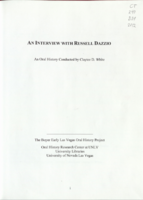
Transcript of interview with Russell Dazzio by Claytee D. White, November 4, 2013
Date
2013-11-04
Archival Collection
Description
A special note: This interview was conducted in two parts before students of the UNLV College of Hotel Administration. Mr. Dazzio serves as a member of the college's International Advisory Board. During the interview he shares stories of his path from the son of an early dealer to being twenty-something working at the Stardust with Al Sachs and Frank Rosenthal to being a cofounder of R&R Global Hospitality. It was unlikely that Russ Dazzio's father had any idea of what he was bringing his young family into when he moved to Las Vegas from Pueblo, Colorado and became a dealer in the early 1950s. A few months afterwards, five-year-old Russ and his mother stepped off the Union Pacific train to join him. They walked down Fremont Street, "a tree lined horseshoe sidewalk", to the casino where his father dealt cards. No minors were allowed, so young Russ sipped an ice cold Coke and waited. From that point on, Russ's life became entwined with the growth and evolution of Las Vegas. After graduating from Western High School in 1968, Russ became one of the first students of the Hotel College at UNLV (then Southern Nevada). His studies were interrupted by enlisting in the Army during the Vietnam War, but he returned to his studies. During this interview he recalls his career path from a thirteen-year-old bus boy at the Thunderbird Hotel for $1.25 an hour to a finding himself working closely with Stardust executives Al Sachs and Frank Rosenthal while in his early 20s. He garnered a wealth of experiences in his jump from the Strip to an international chain of successful hotels The interview is sprinkled with humorous stories and sage advice from a successful hotel operator for the ITT Sheraton chain and founding partner of R&R Global Hospitality, a third party management firm (started in 1985). This is a business story filled with the ups and downs caused by two recessions in the 1980s. Today Russ is ever-busy with projects underway. He maintains a close relationship with UNLV's Hotel College, serving on the International Advisory Board and is proud of being an alumnus.
Text
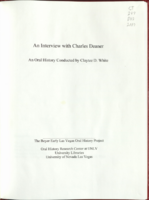
Transcript of interview with Charles W. Deaner by Claytee D. White, April 4, 2011
Date
2011-04-04
Archival Collection
Description
Charles Deaner's narrative begins near Erie Pennsylvania, where he was born. His family history can trace its roots to a grandfather who fought in the Civil War. Charles served in the Air Force and battled in the North African campaign of World War II. After which, he attended college and received a law degree from Syracuse University. At the urging of a sister and brother-in-law who had settled in Las Vegas, he ventured to a changing Las Vegas of the 1950s. He shares stories of his first law practice and legal case. Charles became a leader in his profession and has many stories of how his practice grew during the 1960s and 1970s. His narrative also includes his insights and descriptions of the many changes that have occurred over the decades that he has lived and worked in the Las Vegas community.
Text
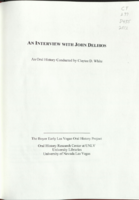
Transcript of interview with John J. Delibos by Claytee D. White, October 2, 2012
Date
2012-10-02
Archival Collection
Description
With roots in Sheboygan, Wisconsin, John J. Delibos epitomizes a true Las Vegan. At the age of eight, his family moved from Wisconsin to Las Vegas to take advantage of emerging employment opportunities. Raised in a devout Catholic household, his mother and father demonstrated a strong work ethic that John would emulate. After graduating from Cornell University, John returns to Las Vegas. Over the course of his young adulthood, John meets many of Las Vegas' key developers, including the McKellars, the Boyds, and the Thomases. He works in various capacities, in various casinos around town. Eventually, John retires from gaming and works full-time as an interior designer, a skill he cultivated since childhood. Throughout the interview, John recollects, with meticulous detail, the development of Las Vegas since the 1960s, neighborhood by neighborhood, street by street, property by property. John now lives at Turnberry, overlooking a very different Las Vegas than that which he first saw as a child living at The DeVille.
Text

Transcript of interview with Thalia Dondero by Claytee D. White, March 6, 2014 and April 2, 2014
Date
2014-03-06
2014-04-02
Archival Collection
Description
Thalia Dondero is most famous for being the first woman elected to the Clark County Commission. She ran her first successful campaign in 1974 and held office for twenty years. While on the commission, Dondero helped to create Red Rock Canyon and Valley of Fire state parks, to modernize McCarran International Airport and University Medical Center, and served on the Water Authority Board. She served as a member of the Board of Regents for the Nevada System of Higher Education for twelve years after retiring from the County Commission in 1994. Dondero died September 4, 2016 from complications from congestive heart failure. Thalia Marie Dondero was born January 23, 1920. Her father, Doyle Sperry, was a taxidermist and her mother, Sylvia Peck, was a violinist and worked in a laundry. She lived in both Colorado and Wyoming before her family settled in Bakersfield, California. Dondero moved to Las Vegas in 1943 when her employer took a job with Basic Magnesium, Inc. and requested that she follow him. On June 21, 1946 she married Harvey Dondero who taught English and journalism for local high schools,. The couple had two daughters and three sons together. Dondero was very active in her community. While her children were in school, she volunteered for the Parent Teacher Association and even served as the organization’s president. She was also very active with local Boy Scouts and Girl Scouts troops in Las Vegas. She served as executive director of the girl scouts and was instrumental in creating the Foxtail Girl Scout Camp at Mount Charleston. Throughout her life, Dondero volunteered with a number of Las Vegas organizations, including the Junior League, the International Women’s Foundation, and the Gilcrease Foundation.
Text
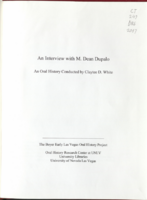
Transcript of interview with Martin Dean Dupalo by Claytee D. White, October 24, 2005
Date
2005-10-24
Archival Collection
Description
Martin Dean Dupalo was born February 20, 1967. His parents were Eva Auge, a German citizen, and Milton Dupalo. Martin shares many stories and anecdotes concerning his family background, his father's 21 year military career, his mother's tribulations in WWII Berlin, and the many sites the family visited all over the world. Martin gives a wealth of details regarding Las Vegas and UNLV in the seventies and eighties. He lists the schools he attended in Clark County and recalls some of the friends and professors his father knew while attending UNLV. Martin graduated from Eldorado High in 1985, attended UNLV, and was selected for a Truman Congressional Scholarship at Carnegie Mellon in Pittsburgh, Pennsylvania. He describes the house and surrounding area in which he and his father and brother, Michael Dean, lived. He also includes comments and anecdotes regarding entertainment in the Vegas Valley. After a stint as a fire fighter, four years in the Air Force and Air Force Reserve, and a brief marriage, Martin began teaching at UNLV in 2003. He discusses race relations as he has experienced them in his family, the military, Las Vegas, and at UNLV. His closing comments are in regard to war, world population, and the possibility of peace.
Text
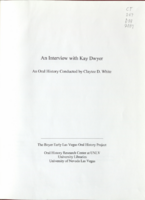
Transcript of interview with Kay C. Dwyer by Claytee D. White, August 16, 2000
Date
2000-08-16
Archival Collection
Description
Kay Dwyer was born August 30, 1934 to James and Eileen Crawford. Her father attained a job as an accountant with Basic Magnesium Incorporated in 1942. This meant that the family moved to Henderson, Nevada, which was a brand new community back in the early 1940's. The BMI plant, which manufactured magnesium for bombs and other war materials, is discussed throughout the interview. The interview begins with Kay reading a composition that she wrote entitled, "Our Summer of 1942 and More." In the reading she talks about the early years of her life when she first moved to southern Nevada. Kay gives remarkable details about the towns of Basic and Henderson (Basic became the town of Henderson) were like during this historic period. In 1952, she graduated from Basic High School and then moved to Los Angeles to attend Pepperdine University for two years. She moved back to the Las Vegas area and started a family with Stanly Hardy with whom she had three children. Sadly, at age 31 Stanly passed away from pancreatic cancer. After a break, Kay decided to go back to school and graduated from Nevada Southern University (now UNLV). Upon graduation, she immediately began teaching at Clark High School. In 1968, Kay married George Dwyer after being a widow for five years. Later, she taught at Las Vegas High School where she would go on to spend the next 25 years until 1995. This interview is an excellent resource for quality information pertaining to the early years of Southern Nevada. Kay Dwyer's extraordinary experiences provide us with a special look at the history of Las Vegas.
Text
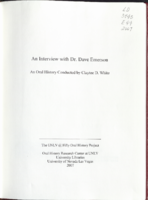
Transcript of interview with Dr. David Emerson by Claytee D. White, December 21, 2005
Date
2005-12-21
Archival Collection
Description
Dr. Dave Emerson was born in Littleton, Massachusetts. His father, a mining engineer, moved the family to Mexico twice, once when Dave was one year old and again when he was seven. In 1938, his father retired to work on his apple orchard in Littleton. Dave helped with pruning, spraying and dusting for insects, and hauling apples to the cider mill. Dr. Emerson graduated from high school in Littleton in 1945 and joined the army. Because he was only 17, the army sent him to Norwich University in Vermont until he turned 18. He then went on active duty until December, 1947. After he mustered out, Dartmouth College accepted his credits and he completed courses through his junior year. He was then called back to active duty in the Korean conflict, and was assigned to the Army Chemical Center in Maryland. After his army stint, Dr. Emerson worked a summer for Dow Chemical as a research engineer, and then returned to Michigan to pursue a Master's degree. He met and married his wife during this time. After completing his doctorate, Dave went to work for Shell Oil Company. Dave spent six years with Shell and decided to turn to teaching. He took a job at a branch of the University of Michigan. He worked there 17 years, doing research, teaching, and even spending a little time as chairman of the Division of Art, Sciences, and Letters. He was then notified of an opening at UNLV for dean of the College of Science, Math, and Engineering. In 1981, Dr. Emerson and his wife moved to Las Vegas, and he began teaching chemistry classes. He was instrumental in building up the engineering department through distance education for students who needed credits in math, computer skills, or electrical engineering. He also helped put together and sell the idea of a strong engineering school at UNLV, and then worked to gain accreditation for civil, mechanical, electrical and other areas of engineering. After retiring in 1998, Dr. Emerson worked on the self-study for the year 2000 accreditation. He still does research at UNLV on a volunteer basis. He and his wife continue to enjoy their home here in Vegas as well as their travels around the country.
Text
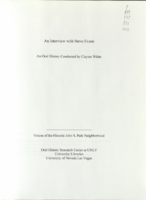
Transcript of interview with Steve Evans by Claytee D. White, June 15, 2010
Date
2010-06-15
Archival Collection
Description
Steve Evans is a native of Henderson, Nevada; living there when it was little more than an industrial town. In this interview, Steve tells of his humble life in Henderson's Carver Park community to becoming the owner of a home formerly owned by a teenage mentor, Flora Dungan, who founded Focus, a youth counseling program where he worked. Steve's penchant for architecture threads through this narrative. Among the stories he shares is of his efforts to recover information about his John S. Park home, which was built in 1964, designed by Kennard Design Group of California and considered the best example of mid-century modern architecture in Las Vegas. In addition, Steve is an informed observer of a community in transition. He tells about the thriving commerce of Fremont Street shifting to Maryland Parkway, the beginning of the Arts District, the impact of events on the John S. Park Neighborhood sense of community, events such as the Stratosphere wanting to build a roller coaster as well as the movement to give John S. Park a historical designation. Steve left Las Vegas for a few years to purse his career in social justice and activism. He returned home and has been a involved in community service, a City Planning Commissioner, Chair of the Downtown Design Review among other committees.
Text

Transcript of interview with Charles Nur Fernald by Claytee D. White, May 31, 2014
Date
2014-05-31
Archival Collection
Description
Dancer Charles Nur Fernald first came to Las Vegas in 1963 to perform for five weeks in the Kay Starr Show at the Sahara Hotel and again in 1964 working with Donn Arden for three months at the Desert Inn Hotel. Born in Detroit, Michigan, in 1939, Charles moved several times to various places in Arizona and southern California with his parents, Charles Knox Fernald and Marguerite Marie Higgins Fernald, and half-siblings before settling in Hollywood, California, where he remained (except for his short stints in Las Vegas) from 1961 to 1967. In January 1968 Charles came to Las Vegas to perform with Sid Caesar and Imogene Coca at the Flamingo Hotel. After the show closed Charles auditioned for Donn Arden to dance in the Lido de Paris show at the Stardust Hotel, where he remained for sixteen years, 1968 through 1984. He remains the only male dancer who performed with Lido through five different, consecutive productions. In 1969 Charles met his partner, Aquiles Garcia, who was a dancer at the Dunes Hotel. The couple remain in Las Vegas and have been together forty-five years. Charles’s father was very poor and left school after the third grade to go to work and help support his family. He was born in 1889 in Philadelphia, Pennsylvania, the fifth of eleven children. As an eight-year-old he became a “groundhog,” a digger of New York’s underwater tunnels, who helped build the Holland Tunnel. At fifteen he made more money than his father selling newspapers, fresh fruit, and clothing door to door or from the street corner. According to Charles, his father “drank too much, ate too much, smoked too much, and loved too much.” As an only child, Charles’s mother had a very different upbringing from his father, although her family too was very poor. She was born in Detroit in 1902 to a railroad switchman father and mother who not only scrubbed the floors of wealthy Detroiters but also cooked meals for twenty-one boarders at a rooming house. Marguerite’s parents worked hard so they could send their only child to Catholic school and the Detroit Conservatory of Music.
Text
Pagination
Refine my results
Content Type
Creator or Contributor
Subject
Archival Collection
Digital Project
Resource Type
Year
Material Type
Place
Language
